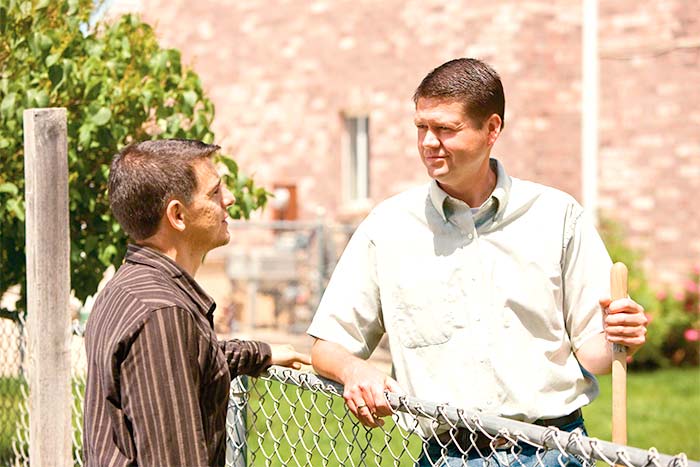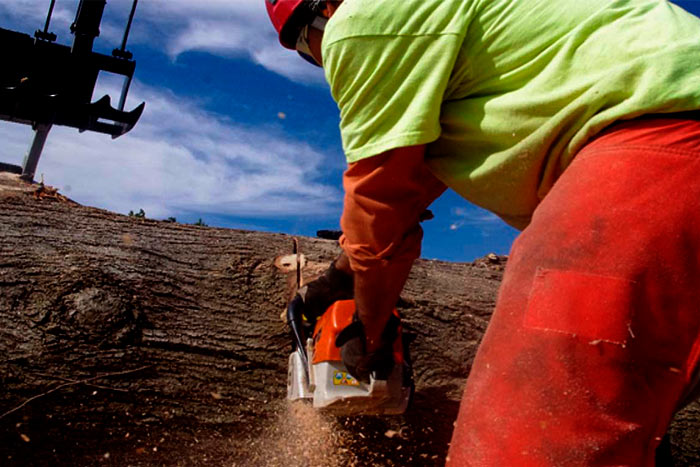Growing trees close to the border may lead to problems as they reach full growth.
Trees should be planted 3 – 4 feet from property lines1 to allow for future growth. Some state laws do differ on this and you may need to refer to your state’s Tree Ordinance and planting trees on private property.
The conflicts that may arise from trees on the property lines are outlined below with their solutions.
What we cover
ToggleWho pays for tree removal on property lines?

Under common law, trees that exist on property lines are considered to be owned by parties on both sides of the property line and so if the tree has to be removed, they will share the costs of removal.
However, if the tree was planted by one of the neighbors, then they are the ones who have to bear the full costs of the removal. This is because by planting the tree on the property line, they essentially encroached on your property by planting part of the tree on your property. And since they are the ones who caused the problem, they are usually the ones who are required to bear the costs of remedying the situation.
It is important to note that local governments, Homeowner’s Associations (HOA), and states can have specific laws and guidelines governing cost allocation in such a situation. Therefore, checking with your local authority, reading through the homeowners association rules, or seeking legal counsel is always a good idea. And if you have a cooperative neighbor, you can find an agreeable solution through either negotiation or mediation.
Can I ask my neighbor to cut his trees?
Yes, you can ask your neighbor to cut his tree down if they are causing you issues such as casting shadows, roots causing foundation damage, and blocking your view. You might not be successful right away, but there are some good tips here on how to approach your neighbor.
Even in cases where the trees block your view, have branches that overhang your property, or are generally considered to be aesthetically unpleasing, you have no right to ask them to cut their trees.
However, you can request them to do so, especially if they have an adverse effect on your property. In such a case, you will be entirely at their mercy, and if they deny your request, you won’t have any legal recourse.
If the trees that the neighbor has planted are poisonous, or if they interfere with a walkway, utilities, or the view on an intersection, you can call the local authority. They may then remove the trees if they consider it to be in the public’s interest to do so.
Some homeowners’ associations have strict rules with regards to the type of trees that one can plant, or the height to which they can be allowed to grow. If the trees that you have a problem with are in violation of the code, then you can contact the association and they can ask your neighbor to remove them.

Can I cut a neighbor's tree overhanging my property line?
Yes, you have the right to trim any branches over your side of the fence, but only if it’s legal. Confused? let me explain.
Certain trees in your county or state are protected and need a permit from the city to trim or remove them. So even though you have the right to trim your neighbor’s tree, you have to first make sure it is legal to do so.
Generally, anything small, you will be fine to trim, larger trees might need a permit.





Can I plant a tree on my property line?
No, if you don’t have the permission of your neighbor, you cannot plant a tree on your property line. This is because doing so will result in your encroaching on their property — since the tree will end up growing on both sides of the property — and this is considered to be a form of trespass. Therefore, they can sue to have you uproot the trees. They can also stop you from doing so since such an act will be in violation of their rights.

How far from a property line should a tree be planted?
While there is usually no law defining the minimum distance from the property line that a tree can be planted, a good rule2 of thumb is to always plant a tree at a distance that is far enough to enable it to reach its maximum size without the trunk growing past the property line.
As a result, knowing the expected diameter of the tree’s crown is imperative to figure out a safe distance. In most cases, a distance of between 6 to 15 feet away from the property line is enough for most trees.
Trees on property line: Your rights
Trees that are on the property line are generally considered to be owned jointly. Since you are legally considered to be a part owner of such a tree, such a tree cannot be removed without your permission. You also have a right to any benefits that result from its sale or profitable use.
With such a tree, you have the right to trim its branches as you see fit. If its roots become a nuisance, you can also cut them. However, your rights to trim or cut the branches only extend as far as your property line. And so if your trimming or cutting efforts extend beyond the property line, you will have infringed on your neighbor’s rights.
However, since the tree is owned jointly, you do not have the right to harm it. Therefore, even when you are trimming its branches or cutting its roots, you have to take every precaution to avoid harming it. If you destroy it, you can be sued for damages and you may end up having to compensate your neighbor for an amount that is more than thrice the tree’s value.
- Glenda Taylor, (2023) Trees and Property Lines: 9 Things All Neighbors Need to Know for Storm Season <https://www.bobvila.com/articles/trees-and-property-lines/> Accessed: 16-02-2024
- Arbor Day Foundation, (2019) Right Tree in the Right Place <https://www.arborday.org/planning-selection-location> Accessed: 16-02-2024





